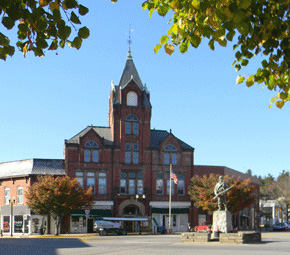MARIETTA, MUSKINGUM
THE MUSKINGUM RIVER
From Marietta, a scenic route follows the valley of the Muskingum River through the picturesque historic towns of Stockport and McConnelsville, and on to Zanesville, enroute to Newark or Columbus. (A long but even more scenic alternative is to follow the Ohio River westward to Cincinnati by way of Gallipolis, Portsmouth, and Ripley with its famous Underground Railroad sites, and not missing the beautiful Kentucky towns of Maysville, Washington, and Augusta.)
As part of Ohio’s canal building project in the early 1800s, the Muskingum River was “canalized” by the addition of a series of channels, locks, and dams. The lock mechanisms, designed to be operated by hand, are still functioning. Boats are able to navigate the river today using this same infrastructure, still visible along the riverfronts in Beverly, McConnelsville, and other riverside towns and villages.
In 1896, archaeologist Warren Moorehead and a few aides left the town of Coshocton to survey mounds and earthworks in the Muskingum valley. His notes describe Native sites now lost: pictographs on a large boulder depicting bird tracks and other figures, plus a great face carved in a rock. It’s possible that many markers and symbols once greeted people moving down this river. He investigated the large Sprague Mound then standing, as he noted, “directly in the heart of McConnelsville,” and gave a lecture on his work in the Opera House.
Moorehead’s report suggests the valley had at least 60 mounds, some on the river terraces, some with rings, some high above on bluffs. The locals told him that most of the mounds were places of observation rather than burial, probably much like the grouping at The Plains near Athens, also from the Adena era.

The Opera House where Moorehead spoke is still in use, dominating McConnelsville’s well-preserved, diagonally-oriented town square.


